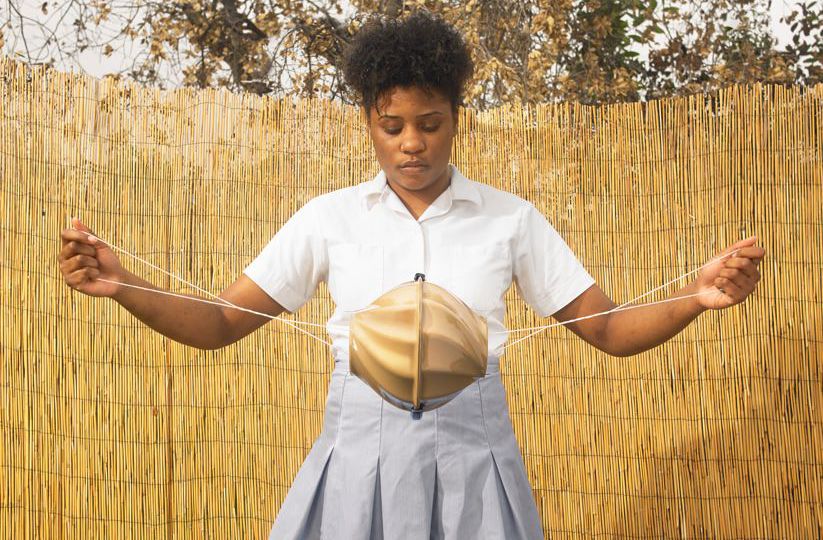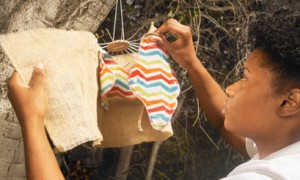
Across societies, the taboo regarding menstruation is evident not only in the euphemisms employed to discuss it, but also in the elusive silence surrounding it. This leads to a great deal of ignorance about menstruation and has a massive impact on the ways in which women learn to deal with it. The onset of menstruation represents sexual maturity to the extent that it renders women capable of bearing children and this, within a marriage, is the only acceptable expression of female sexuality for the majority of society. The prohibitions placed on menstruating women, either through the application of taboos or through putting in place systems of denial regarding the menstruation cycle, such that it is unacceptable to even openly discuss it, then beg the question of the ways in which women’s sexuality is suppressed.At the same time, an insight into the multiple techniques of menstrual management also reveal a plethora of innovations within the ‘period industry’ which occur alongside indigenous ways of dealing with menstruation across societies. It is these innovations, industrial or domestic, that I choose to understand as tying together science with menstruation.
A WaterAid report published in 2010 highlights the impact that the neglect of menstrual health has on girls’ education, health and development in South Asia.[1] It argues that the negligence of menstrual hygiene management, which ought to include the physical infrastructure and cultural environment to handle menstruation with hygiene and dignity, leads not only to cultural practices of segregation but also to health problems caused by insufficient facilities to deal with menstrual bleeding. This in turn has a negative impact on the lives of girls’, further reinforcing gender inequities and exclusion. While this canbe attributed to the absence of women’s voices in the public sphere, such that their experiences and needs are not taken into account when addressing questions of development, the shame and embarrassment surrounding the subject of menstruation are also of grave concern.
Owing to an absence of formal knowledge and awareness regarding the menstrual cycle, information about which is usually passed on by mothers to daughters or between female peers and is often incomplete, many women in rural and semi-urban areas resort to using reusable cloth-rags, torn from old saris, to absorb menstrual blood. While the usage of cloth in itself is not problematic, certain fabrics may be more prone to causing infection. Moreover the lack of facilities including clean water, and private toilets coupled with the secrecy surrounding menstruation that keeps women from drying the used rags out in the sun (which aids in killing off bacteria), often lead to numerous health hazards. Further, many girls are found to drop out of schools once they attain puberty, due to an inability to adequately deal with menstrual bleeding caused by a lack of structural facilities and erroneous information regarding menstruation.This, then, fuels a cycle of neglect wherein cultural ideas of purity and pollution also contribute to the paralysis of women’s development.
At the other extreme lies the ‘period industry’ that thrives on certain ideas and beliefs it propagates through the media. It hascreated a market for itself where products such as tampons,sanitary napkins and disposable pads have become an indispensible part of the lives of urban women. While on the one hand women’s movements have questioned the imposition of the luxury tax on the purchase of tampons in the United States, a continued association of period blood with ‘dirt and impurity’, along with the embarrassment involved in discussing menstruation, has meant a severe lack of discussion regarding the hazards involved in using these products.
One of the growing concerns regarding disposable menstrual products such as tampons and sanitary napkins is their impact on the environment. In recent years, the increasing number of pads and tampons filling up landfills, and the non-biodegradability of the materials used to produce them, is certainly a problem that cannot be ignored. Moreover, the toxic chemicals that these products contain are harmful not only to the environment but also to the body. While it is not uncommon for large corporations to sponsor scientific studies to debunk such concerns, the relation of Toxic Shock Syndrome to tampons is widely recognised. What such knowledge, though limited as of now, has led to is a small movement towards products that are safer, both for the body and the environment. A movement back to reusable cloth pads or even towards the use of menstrual cups aims not only to create ways of dealing with menstruation that are healthier for the body and the environment, but also to open up a dialogue regarding the taboos and inhibitions regarding menstrual blood that stem from culture as well as paid media.
A large number of women shy away from using reusable menstrual products due to a perception of menstrual blood as being dirty and ideas about reusable products thus being unhygienic. In reality, however, if utilised with proper care and hygiene, reusable cloth pads or menstrual cups prove to be healthier and a lot more economically viable due to their very reusability. A number of local enterprises, such as ecofemme, that produce reusable cloth pads have now cropped up, and they often function with the ideals of revitalising menstrual practices that are healthy, environmentally sustainable, culturally responsive and empowering for women. Other innovations address issues of shame and embarrassment regarding openly using, washing and drying these cloth pads, which are at the forefront of reservations regarding their usage. One such example is that of an easy-to-use tool called Flo created by a group of students at the Art Center College of Design in California, which can assist girls, particularly in low income societies, to wash and dry reusable sanitary cloth. The product which is made up of a plastic basket inside two bowls holds water and detergent and is joined using string which can be used to give it a spin. In addition, the two bowls also cover the rags and the basket can be pulled out for hanging the wet cloth in the sun, around which a burlap cloth can be tied to ensure privacy.This, then, directly tackles the problems of girls feeling the need to hide their used rags in dark, secret places, which is a health hazard.

Other innovations include a closer involvement with growing technology in the form of apps such as my.Flow, where a tampon monitor connected to a Bluetooth wearable device that can track the saturation level of the tampon. Such an app addresses the fear of ‘leaking in public’ and the shame of having anyone know that you are on your period. The importance of keeping your menstrual cycle a secret is reflected in the constant terror women seem to face regarding ‘staining’ themselves and in the creation of such products that seek to prevent such embarrassment. While such women-led innovations may address issues that men in the period industry would probably never tackle, these products only go on to reinforce menstrual taboos. It is nonetheless important to recognise the contribution that women in science can have on grappling with such women-centric issues.
Numerous instances of innovations by women to manage menstrual bleeding have taken place over time and across societies. Egyptian women in 15th century B.C. found creative uses for papyrus, while women in Africa and Asia experimented with absorbent mosses, and the nurses of World War I repurposed cellulose bandages. Similar is Lillian Gilbreth’s use of women’s insights while working with Johnson & Johnson, to reinvent sanitary pads. The feedback she received from women brought to the fore their dissatisfaction with the brick-like pads, which they had been altering to fit their bodies. The men in charge of these corporations, however, did not consider the discomfort women faced with their pre-existing products and her pursuit became the exception rather than the rule.95% of modern day patents for sanitary napkins are also male-owned and this leads one to question the degree to which the safety and comfort of the users of these products is a concern for these stakeholders.
It is in this regard that the efforts of women in science, working specifically on female oriented innovations, become all the more commendable. The experience of Ridhi Tariyal, an engineer looking to develop a way for women to monitor reproductive disorders at home using menstrual flow and transforming it into medical samples, is one such instance. The opportunity to utilise the monthly discharge of blood without using needles escaped her male colleagues, whereas her experience as a woman led her to capitalise on. The project, which is still underway, seeks to use the blood in tampons to detect warning signs of disorders such as endometriosis.
While such efforts are laudable, one might probe the degree to which innovations surrounding menstruation are controlled and influenced by the cultural power of the almighty ‘period industry’. As the latter itself thrives on the back of misconceptions, taboos and secrecy regarding menstruation, it necessarily relegates sustainable and healthy means of menstrual management to the sidelines.This becomes evident as the tampon is assumed to be the ‘natural choice’ for the purpose of such innovations. As noted earlier tampons and sanitary pads can prove to be hazardous to the environment and the body but continue to remain extremely popular due to their projection as being indispensible, by the ‘period industry’. What needs to be highlighted, then, is the alternative possibility of innovations using sustainable and healthy menstrual products.
—
[1]Mahon, T. & Fernandes, M. (2010). Menstrual Hygiene in South Asia: A Negelected Issue for WASH (Water, Sanitation and Hygiene) Programmes. WaterAid. London: Gender and Development
Images courtesy the Flo website.